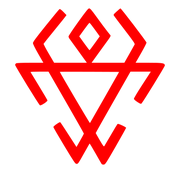Chernobog (Proto-Slavic *čĭrnŭ "black" and *bogŭ "god"), also spelled as Czernobog, Tchernobog is a Slavic deity, whose name means black god, about whom much has been speculated but little can be said definitively. The only historical sources, which are Christian ones, interpret him as a dark, accursed god, but it is questionable how important (or evil) he was really considered to be by ancient Slavs.
About Chernobog, there was just one written document named Chronica Slavorum from Saxon missionary Helmold that says:
„Est autem Slavorum mirabilis error; nam in conviviis et compotationibus suis pateram circumferunt, in quam conferunt, non dicam consecrationis sed execrationis verba sub nomine deorum, boni scilicet atque mali, omnem prosperam fortunam a bono deo, adversam a malo dirigi profitentes. Unde etiam malum deum lingua sua Diabol sive Zcernoboch, id est nigrum deum, appellant."
Translated as:
Among Slavic people, there is one weird belief that is kept in their drinking fests and feasts. They at same time bless and curse under names of their Gods, respectively in the name of good One and evil One, saying that good things come from good God and evil comes from evil One. In their language they call evil God "Chernobog," or "black God."
This text takes an important role in understanding Slavic beliefs. But since this text represents only Polabian Slavs, it is unknown if Chernobog is known among other Slavic tribes. There is no historian that denies his existence, but they assume that, according to Helmold's script, he is not original Slavic God, but rather created under Christian influence and he is equivalent of Christian devil.

Symbol of Chernobog used by modern Slavic polytheists
In Pop Culture[]
Chernobog has made appearances in various media. As Chernabog, he features in the "Night on Bald Mountain" sequence in Disney's Fantasia (1940), as a gigantic black demon who summons ghosts and demons. In an interview, Walt Disney referred to him as Satan himself. This rendition also appears in the video games Kingdom Hearts and Kingdom Hearts Dream Drop Distance, in both, as a boss character.
In literature, he appears in American Gods by Neil Gaiman, as "Czernobog, and is the demon possessing the Tsar in Spinning Silver by Naomi Novik. In the alternate history novel The Peshawar Lancers, the Russian Empire turns to Chernobog worship after a comet impact causes widespread famine and cannibalism. Chernobog is also the main antagonist in the Heirs of Alexandria series by Mercedes Lackey, Eric Flint, and Dave Freer. A version of Chernobog is also used in Richard Kadrey's third novel in the Sandman Slim trilogy, although it is spelled as "Chernovog." Chernobog is mentioned several times in the Kate Daniels series by Ilona Andrews, his volhv (priest) is a regular character in the series, and Chernobog appears in the penultimate book of the series, where he is invoked on a battle field.
He also appears in a number of video games, usually as a villain. In the Blood series (where the name is spelled as "Tchernobog") he is depicted not as a person but as an essence of a force that keeps the realities together and must be used by persons incarnating the god. The first game features an incarnation as the main villain, and the second game's plot revolves around the main character Caleb actually being the god. He has also appeared as a recurring demon in the Megami Tensei series.
Chernobog inspired the character of Avoozl the Dark One, the dark master of the penultimate antagonists Katrina and Ad-Avis in the Sierra Entertainment adventure-rpg Quest for Glory IV: Shadows of Darkness in which he is worshipped by a cult of horrendously mutated priests called "The Chernovy"
Chernobog appears in MOBA game called Smite as very first playable God of Slavic pantheon. In game, he is represented as demon-looking winged being with crystallized hands, feet, horns and place on chest where heart is supposed to be, wearing purplish-red loincloth with his symbol painted on it.
Gallery[]





